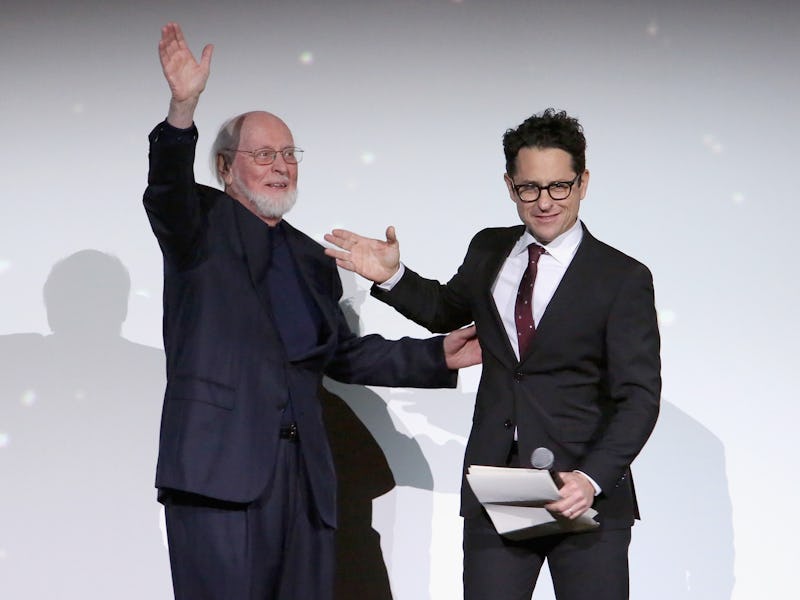Why You Can’t Hum Any of the Tunes From John Williams' 'Star Wars' Soundtrack for ‘The Force Awakens’
Times and stakes have changed for a 'Star Wars' score, and John Williams is a full 83 years old.

Did you come out of the theater at The Force Awakens humming any brand new Star Wars melodies? Did you note any fantastic, unexpected music cues? Unlikely. Yet a lot of new music is in the film. Like any Star Wars flick, the music is invasive, intended to be a large part of the experience. The movie may be full of fan service of various sorts, and it certainly does not overdo reprisal of the series’ classic themes — I could argue that there may even be too little repetition. However, nothing new fails to leave much of a mark, for better and for worse.
The most memorable new theme of the film comes very early on — when Rey first appears, foraging in the Jakka desert and then sliding down a huge dune to her hovering, puttering sand vespa. “Scavenger” starts out as a kind of wispy exercise, based around an oboe futzing around like bush-league Prelude to the Afternoon of a Fawn, but as it gets into full gear with its twinkling vibes — vaguely redolent of The Nutcracker — and pulsating rhythm, you see that Williams is going for a different type of gold here.
As immutable as Williams’ style and sense of melody is in the original soundtracks and those of the prequels, times have changed a lot since the ‘70s, ‘80s, and even the turn of the millennium. Even “Anakin’s Theme,” introduced in Menace, has a pleasant, almost Randy Newman-ish lilt not found anywhere in Abrams’ film. But nowadays Philip Glass and post-minimalist-styled classical music — Hans Zimmer is perhaps the median Hollywood example at the moment — set the tone. This music is all propulsive rhythms, bombast, and haunting, cyclical chord progressions, with little in the way of catchy tunes.
Williams is no Glass: His sweeping dramatic gestures and rich chord progression are still based heavily in the work of late 19th-century, post-Romantic masters of the large orchestra like Mahler, Strauss, and Wagner. But though he’s now an octogenarian, Williams is also not completely behind the times. In soundtracks today, a pretty melody is simply no longer the measure of a good character “theme” or credits sequence. The fact that “The Scavenger”/“Rey’s Theme” — which consists of small, echoing snippets of jittery half-melody being passed back and forth across the orchestra — is the major new theme introduced in The Force Awakens signals that we are in a new era for music and Star Wars. Raw mood and kinetic energy — not songcraft — is the message on this soundtrack.
This theory is borne out across the rest of the soundtrack. “I Can Fly Anything” is unfettered angular, dissonant sound effect music, emulating the sound of Poe Dameron and Finn’s TIE fighter struggling to the other action sequence cues follow suit, sometimes infused with galloping, Spanish-sounding rhythms (see the hooks in “Follow Me” and “The Falcon”). This is not much different than much of the earlier Star Wars music, but really, it’s all ricocheting movement. You can’t tell them apart too well, and there’s no triumphant whistle-along moment. As you might imagine, “Scherzo for X-Wings” — despite a hilarious title — is much the same way: all the horn section playing one note as many times and as fast as they can, as if emulating blaster fire.
And don’t expect a triumphant sequel to the Imperial March. There isn’t snappy music for the evil people here, either. “Kylo Ren Arrives at the Battle” and “The Abduction” are just sneaky, sinister interpolations of “The “Force Theme” melody, punctuated by dramatic blasts and string double-times possible, arranged in seemingly no meaningful order; all smoke, no fire. Supreme Leader Snoke gets some lower-than-hell bass fake Gregorian chant backdrops, and some ghostly string shivers — one of the better moments of the score. But perhaps that’s because it doesn’t hedge its bets. It’s all texture and eerie, seasick chordal motion, no melody is even hinted at.
You know what’s beautiful? “Han and Leia.” That’s because it’s an outgrowth of music we’ve heard before — melodies Williams has been teasing out since “Princess Leia’s Theme” from A New Hope. These are old characters, full of an old love, and there’s old music to fit it. That’s soundtrack scoring for you: put a new coat of paint on the classic hits. Don’t worry, be happy. There was really no call to reinvent the wheel here.
Williams’ approach has changed since he crafted the music — mostly across Episode IV and V — to the previous Star Wars films, but not in any kind of daring, even deliberate way. It sounds more like the inevitable bit of drift that occurs when you are a tear-jerking film score mercenary who has literally seen and done it all at this point. It’s also significant that Williams is working with Abrams here — a new-school blockbuster director of the Christopher Nolan era, who moves things along at such a fast pace that there’s not a whole lot of time to stop and reflect on what the current background jam is.
I’m sure Williams is excited to be back doing Star Wars, but you can’t force a great tune, and maybe that’s no longer the point for him or the franchise anyway. You see Star Wars and you want the Williams touch — well, you’ve gotten it. This is what it sounds like these days.
I’m not saying The Force Awakens soundtrack is no better than the War Horse soundtrack, but I’m also not completely ruling it out.